If you want to make the most delicious sauerkraut ever, learning how to make sauerkraut in a crock is the ultimate skill to have! This simple method will give you the most flavorful, probiotic-packed sauerkraut you’ve ever had. Once you try it, there’s no going back!
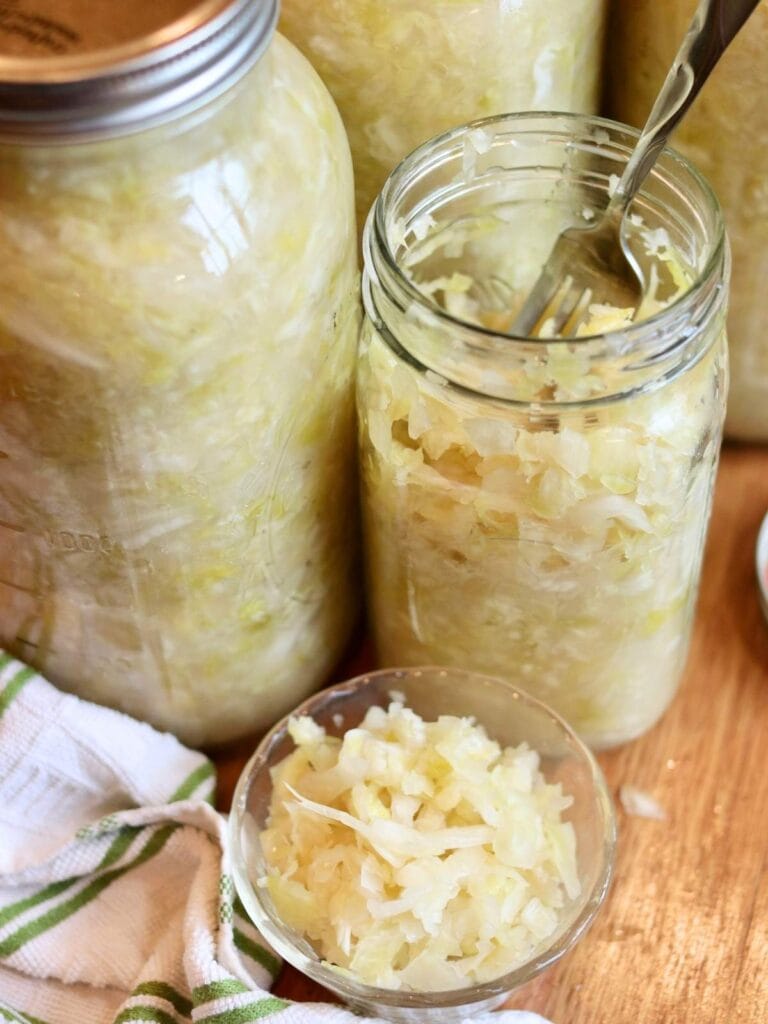
A few years ago my husband gave me a 10 liter fermenting crock for my birthday, and I have to say it was one of the best gifts I’ve ever gotten!
Not only did my sauerkraut success rates go through the roof (I used to struggle with mold and kham yeast), but the crock’s large size helps us to never run out of sauerkraut.
Over time I’ve perfected my method for making sauerkraut, and now our fridge is always stocked with the tangiest, most delicious sauerkraut you’ve ever tried. I’m excited to share this method with you!

Why You’ll Love this Recipe
Simple ingredients – You only need cabbage and salt for the best sauerkraut ever!
Fail-proof method – Closed fermenting crocks are the most fool-proof way to make sauerkraut. Say goodbye to your struggles with yeast and mold!
Probiotic-packed – Homemade sauerkraut is full of amazing probiotics, and it’s a great way to add more of them to your diet.
Classic delicious flavor – This sauerkraut has the same tangy flavor that’s been loved by many cultures for thousands of years!
Benefits of Making Sauerkraut in a Crock
Less risk of contamination – The water seal protects the cabbage inside the crock from getting contaminated by dirt, dust, or bacteria.
No need to burp – The water seal automatically releases the pressure caused by the fermentation process.
Lower chance of mold or kham yeast – Crocks create an environment ideal for fermenting which lowers the risk of mold or yeast growing.
Easy to make large amounts – If you go through lots of sauerkraut, this is a great way to make it in bulk!
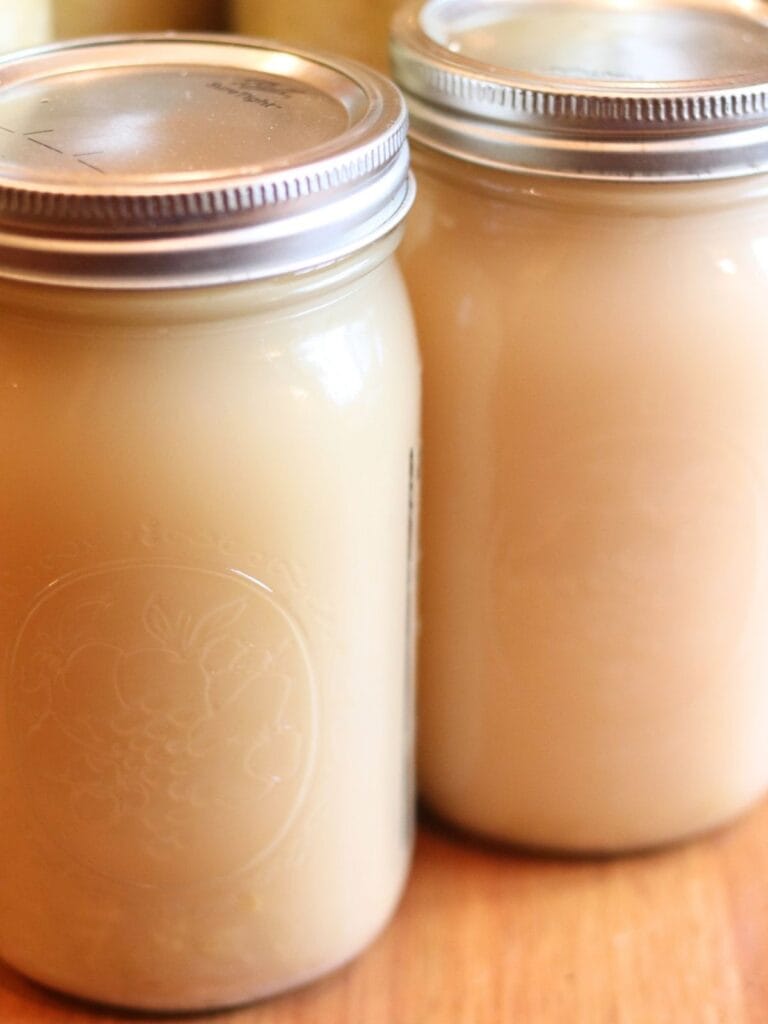
What to do with the Juice
When you make sauerkraut in a crock, you typically have much more juice than you want in your final product. This is a good thing!
Save the juice to start other ferments, such as fermented peppers, or enjoy it in one of the following ways:
- Substitute for the vinegar or lemon juice in homemade vinaigrette dressing
- Add to meat marinade
- Put in smoothies for a probiotic kick
- Take small shots for the nutrition
- Drizzle over cooked meat or vegetables
- Add to soups and stews
- Use in dips
How to Store
Once your sauerkraut is done fermenting, you can store it in the fridge for 4-6 months. As it sits, it will continue fermenting slowly, and the flavor will develop even more.
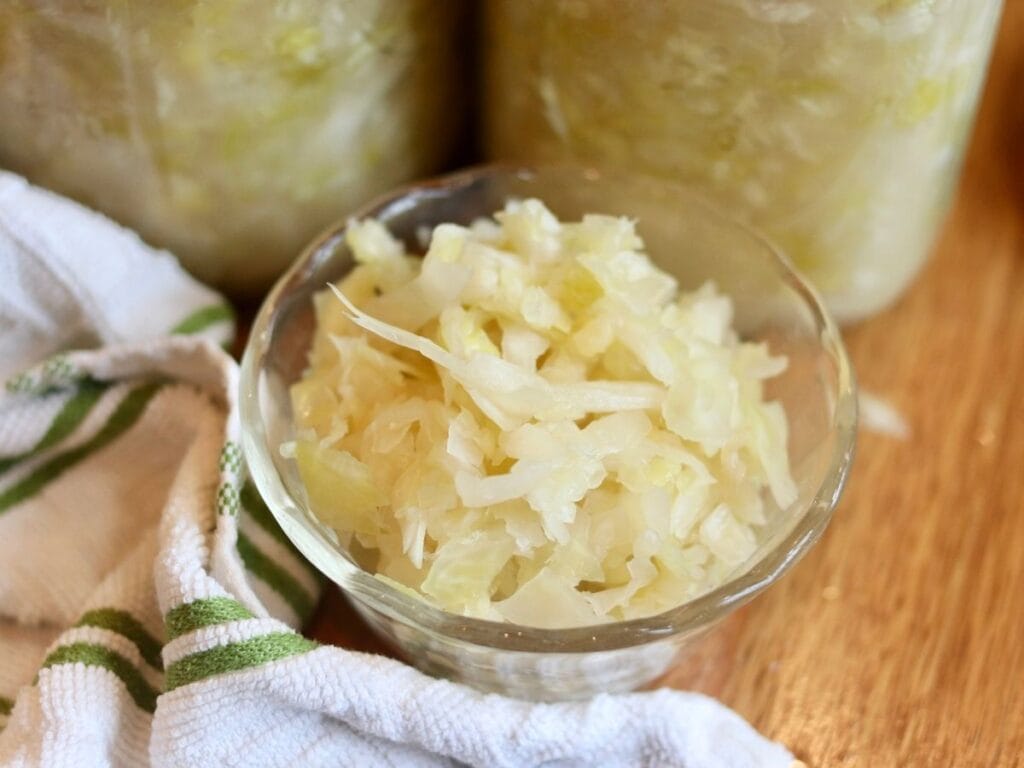
Tips for Success
Use High Quality Cabbage
The fresher and juicer the sauerkraut the better! Sauerkraut is best made while cabbage is in season, however, I’ve had success at each time of the year as long as I buy it from a quality source.
Standard grocery stores (such as Walmart) often have the lowest quality cabbage, upscale/healthy grocery stores (like Natural Grocers and Publix) are usually slightly better, and fresh from a farmer is the best! If you don’t have a local farmer you can buy it from, I have had wonderful success buying cabbage from Azure Standard.
Let the Cabbage Rest Before Pounding
As it sits, the salt will begin the process of drawing the juice out of the cabbage. This will make pounding it so much quicker and easier!
Make Sure There’s Enough Juice
When the cabbage has been packed into the crock, there should be a minimum of one inch of juice covering it. The more the better!
If you don’t have enough juice, simply dissolve 2 tablespoons in a quart of water, and add however much of the water you need.
Not having enough juice indicates that either you didn’t pound the cabbage enough or it wasn’t fresh.
Be Patient
Sauerkraut tastes the best when it has fermented for 2-3 weeks. To avoid contaminating it, once you close the lid, don’t open it until it’s done!
Keep it at the Right Temperature
Sauerkraut ferments best between 65 and 70 degrees, however, it will be fine as long as it’s kept between 60 and 75 degrees.
If the temperature in your home is above 75 degrees, wrap the crock in a damp towel to keep the temperature lower. During the winter, make sure to keep it in a temperature-controlled environment that does not drop below 60 degrees.
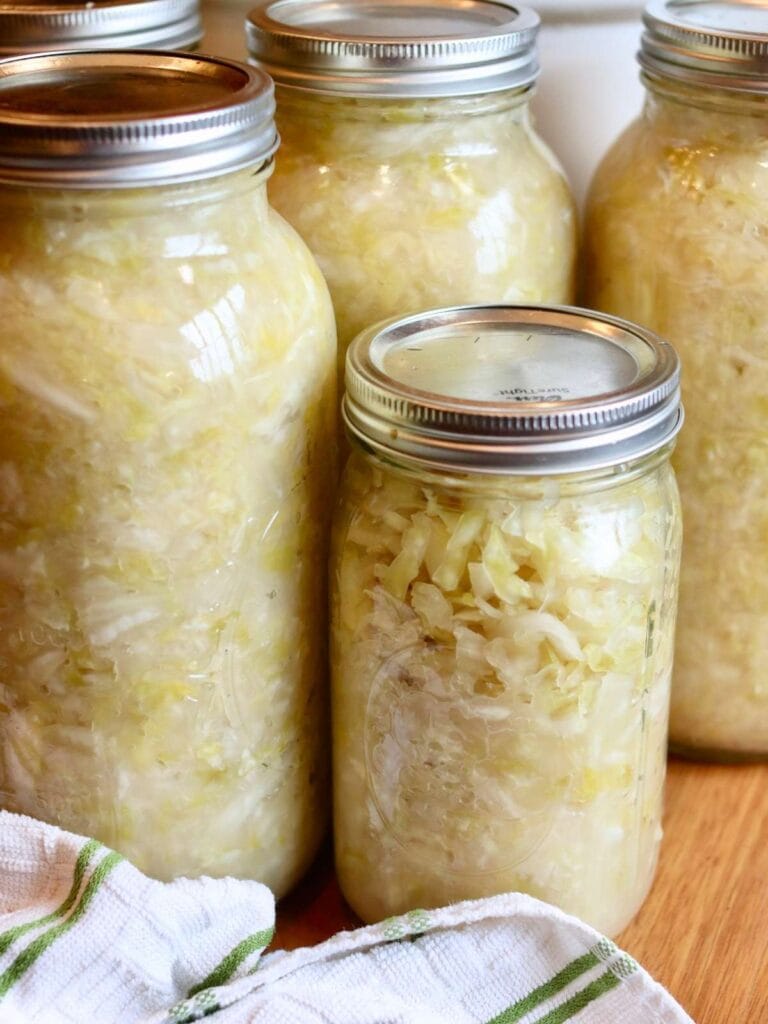
FAQs
Sauerkraut fermented at room temperature (between 65 and 75 degrees) is best when fermented for about 2-3 weeks. If the temperature is cooler, it can take an extra week or two.
A crock can comfortably hold about 5 pounds of shredded cabbage per gallon crock capacity. So a 1 gallon crock would hold 5 pounds, and 3 gallon crock would hold 15 pounds, and a 5 gallon crock would hold 25 pounds.
While these numbers are how much cabbage a crock will comfortably fit, I have had success putting a lot more cabbage in it than is recommended,
When you purchase cabbage, keep in mind that you’ll need to purchase about 20% more weight than you’ll need since you’ll discard the core and outer leaves.
Any salt without any additives or iodine will work for making sauerkraut. Sea salt or Himalayan salt are two of the best options.
A water seal crock is the best option for making sauerkraut since it effectively seals out contaminants. This will help your sauerkraut turn out perfectly every time!
Sauerkraut is typically made with 2% of the weight of the cabbage in salt.
If you’re fermenting in warmer weather or your cabbage isn’t as fresh as it should be, you can increase the salt to up to 3%. If the temperature is closer to 60 degrees, you can decrease it to 1.5%.
Violet’s Tips for Serving
Sauerkraut makes a delicious addition to so many meals! We enjoy eating it as a side dish with meat or as a topping for sandwiches and wraps.
Tools You May Need
This post contains affiliate links which means I earn a small commission at no extra cost to you. See my full disclosure here.
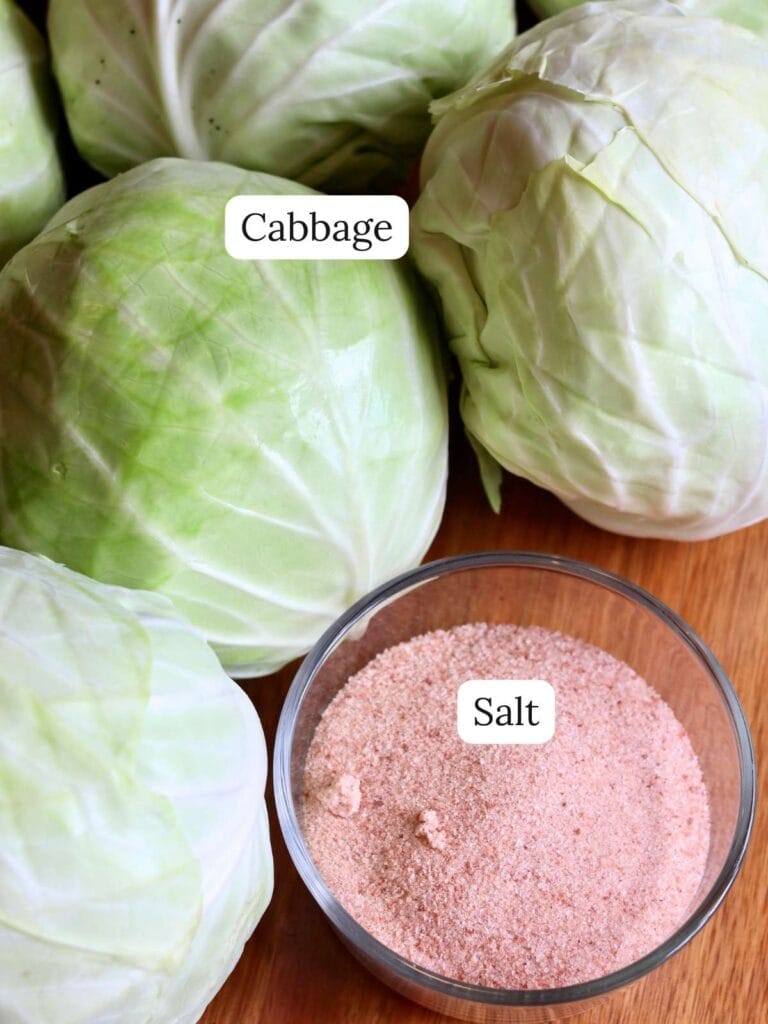
Ingredients
Step-By-Step Instructions
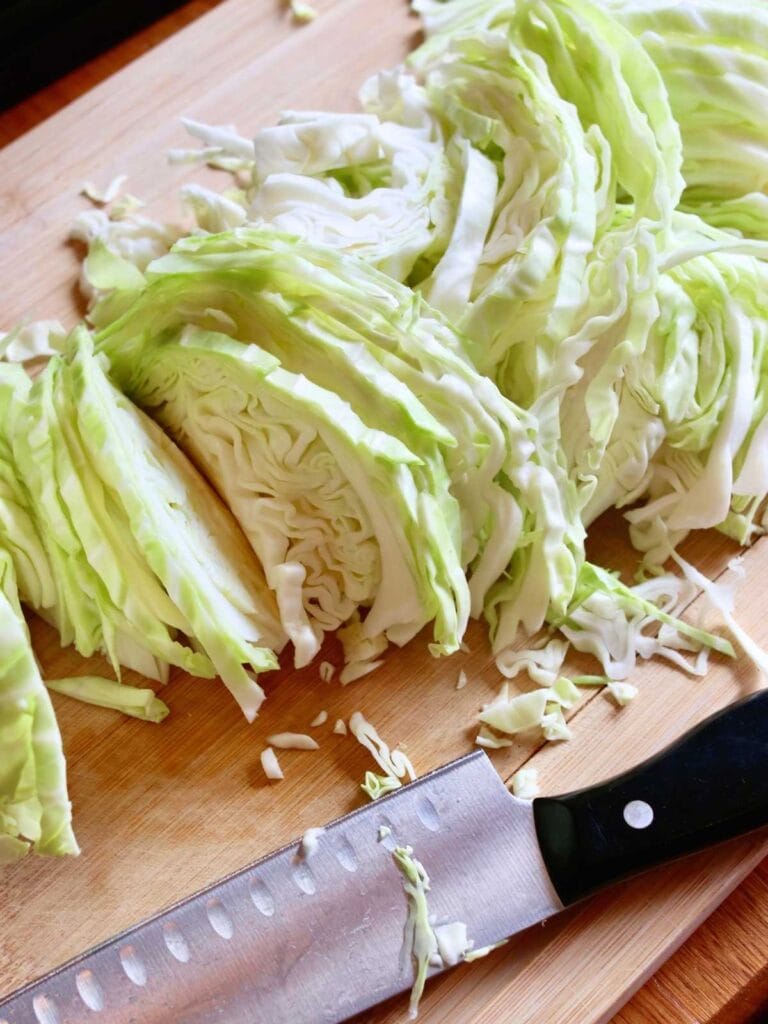
Step 1: First, remove the outer leaves from the cabbages, core them, then slice them thinly.
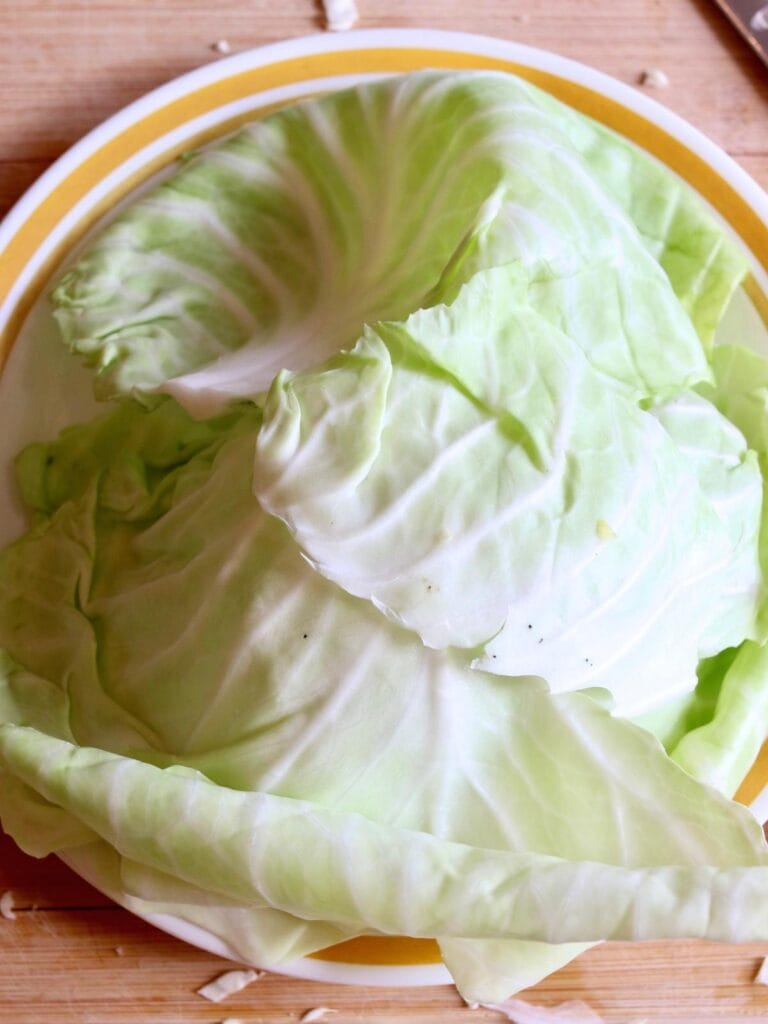
Step 2: Set aside 4-5 clean-looking whole outer leaves for later.
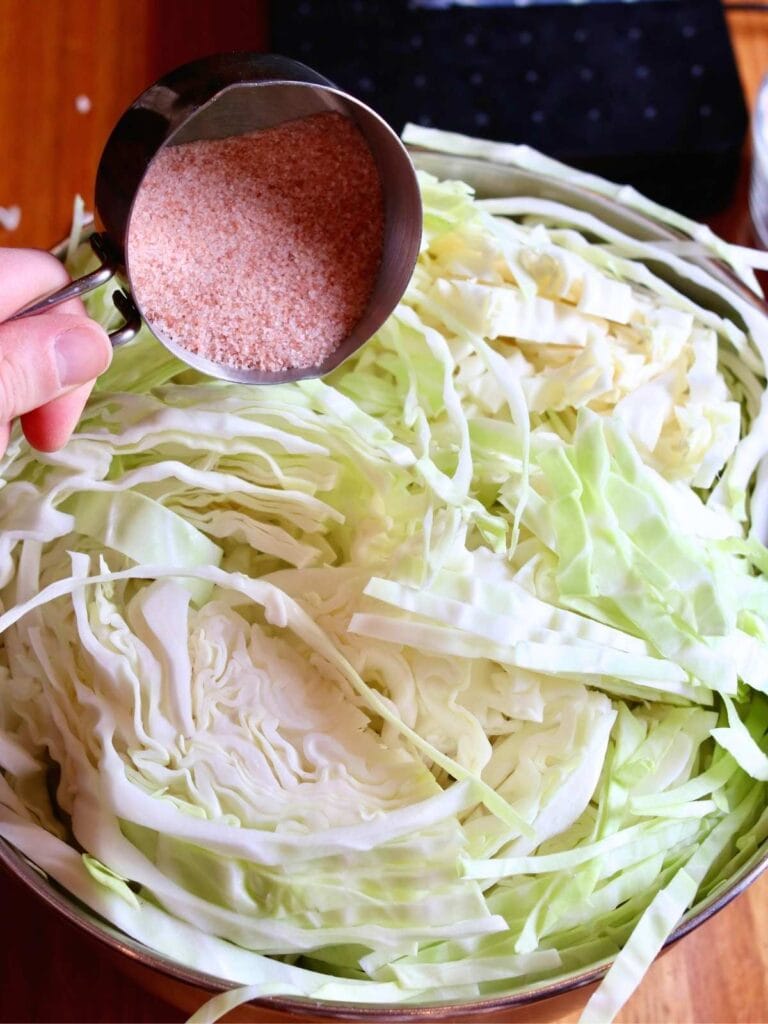
Step 3: Weigh the shredded cabbage and add 2% of the cabbage weight in salt. Toss to distribute it throughout the bowl(s).
It’s easiest to do this calculation in grams, so make sure your scales is set to weigh in grams.
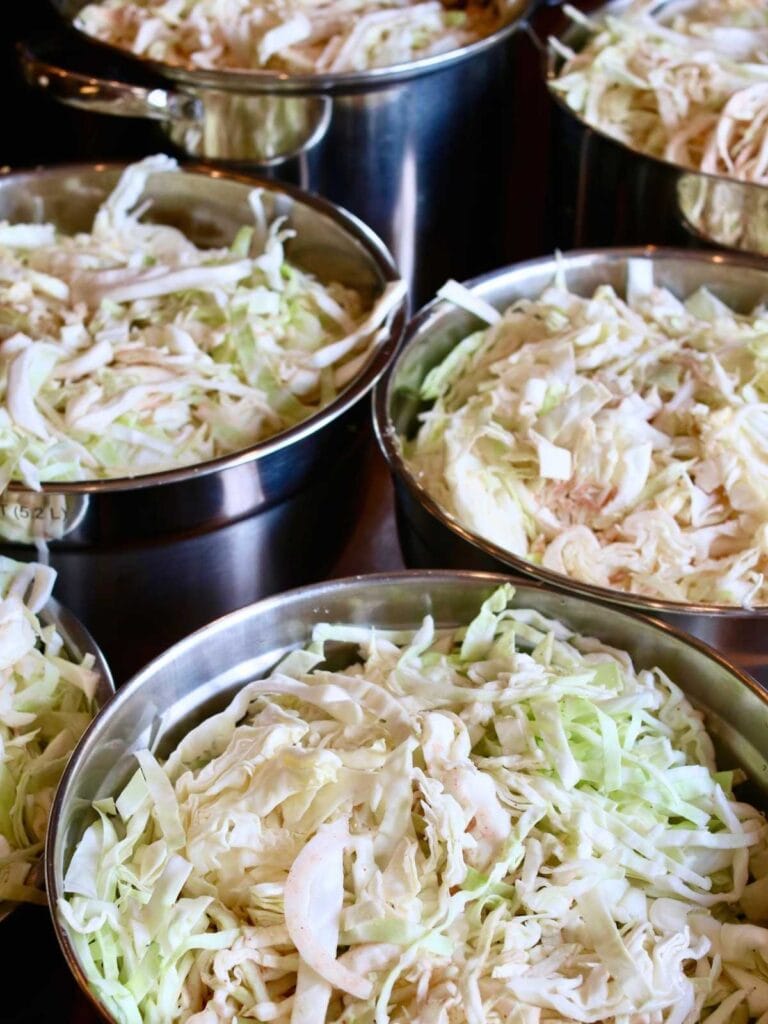
Step 4: Let the salted cabbage rest for about half an hour so the salt can begin drawing out the moisture.
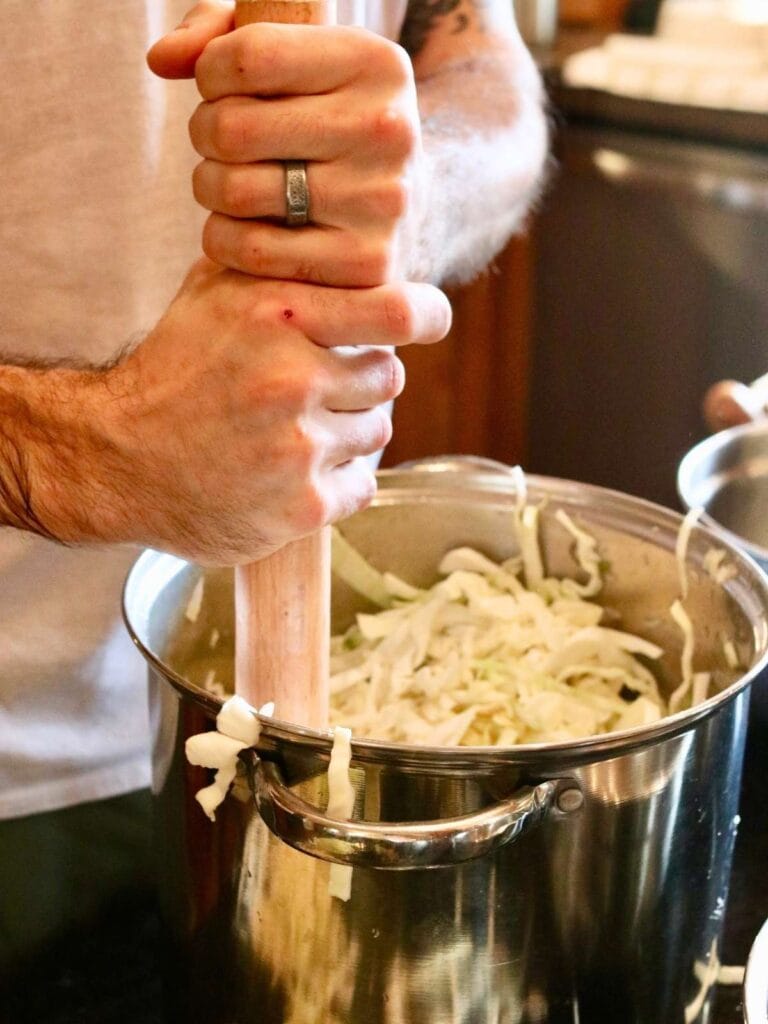
Step 5: Next, it’s time to pound it! Using a cabbage tamper, pound the cabbage until it’s released about all of its juice. This can take a while so be patient.
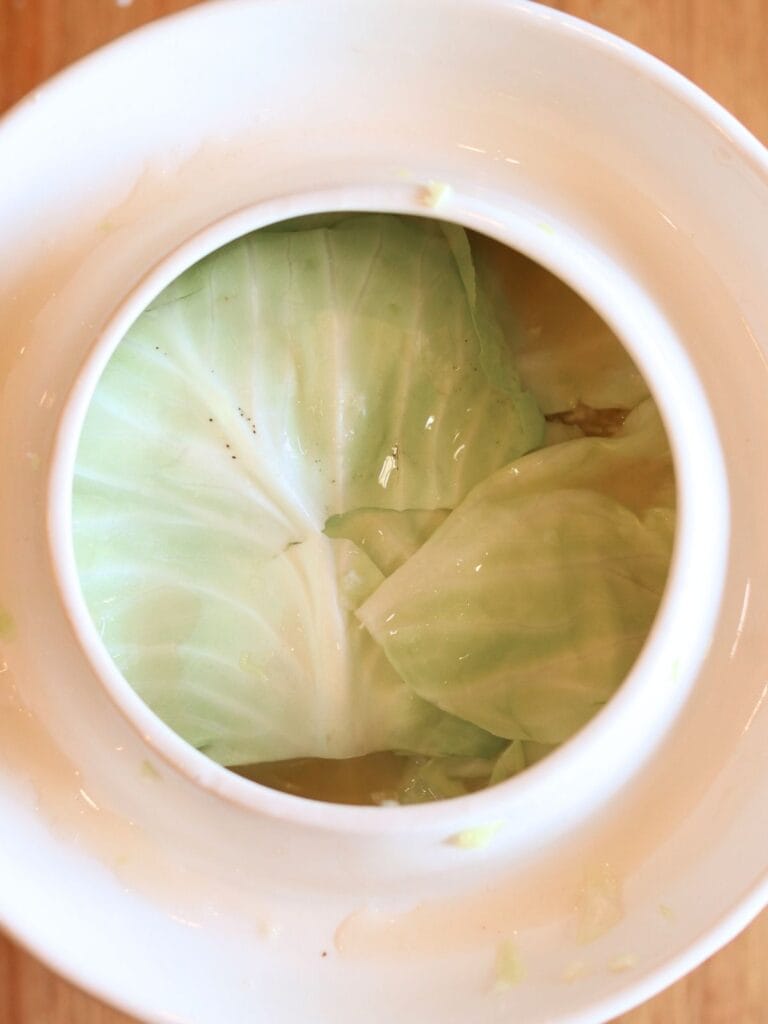
Step 6: Pack the cabbage into the crock as tightly as possible. Then place the whole cabbage leaves on top to minimize the amount of shredded cabbage floating on top of the brine.
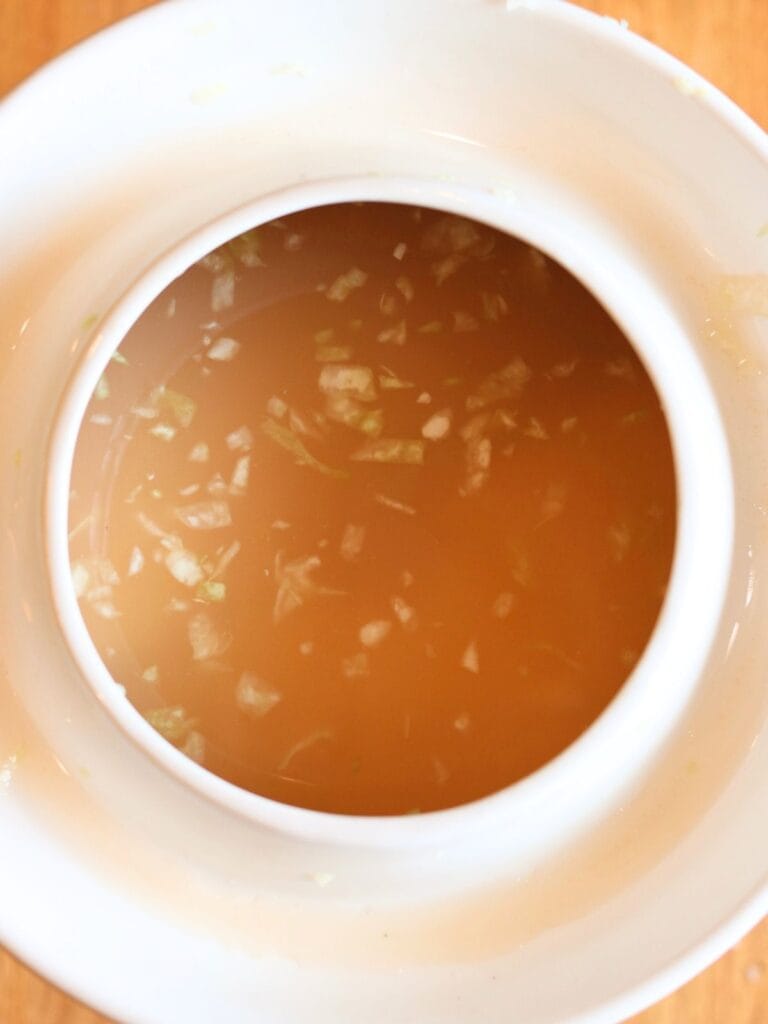
Step 7: Now place the crock weights on top and press down firmly so they’re completely covered with juice.

Step 8: Finally, put on the lid and fill the moat with water. Place the crock in a location between 60 and 75 degrees for about 2-3 weeks.
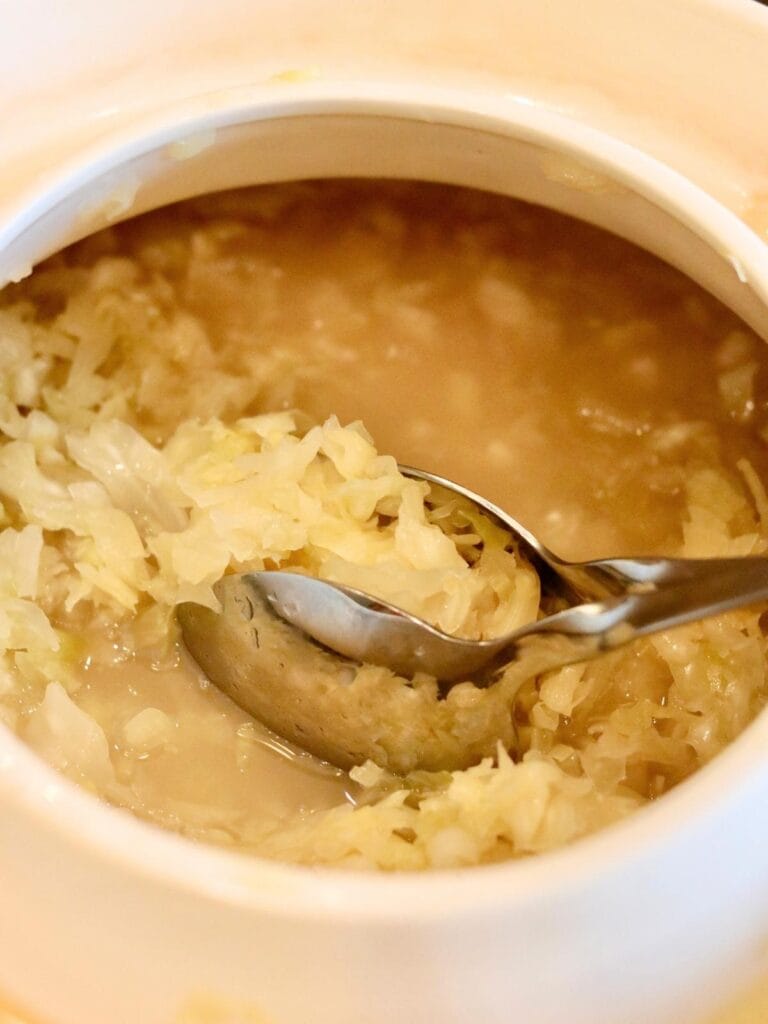
Step 9: Once the cabbage is done fermenting, open the crock and scoop the sauerkraut into large mason jars.
Make sure to save any extra sauerkraut juice as a starter for other ferments or to use in recipes!
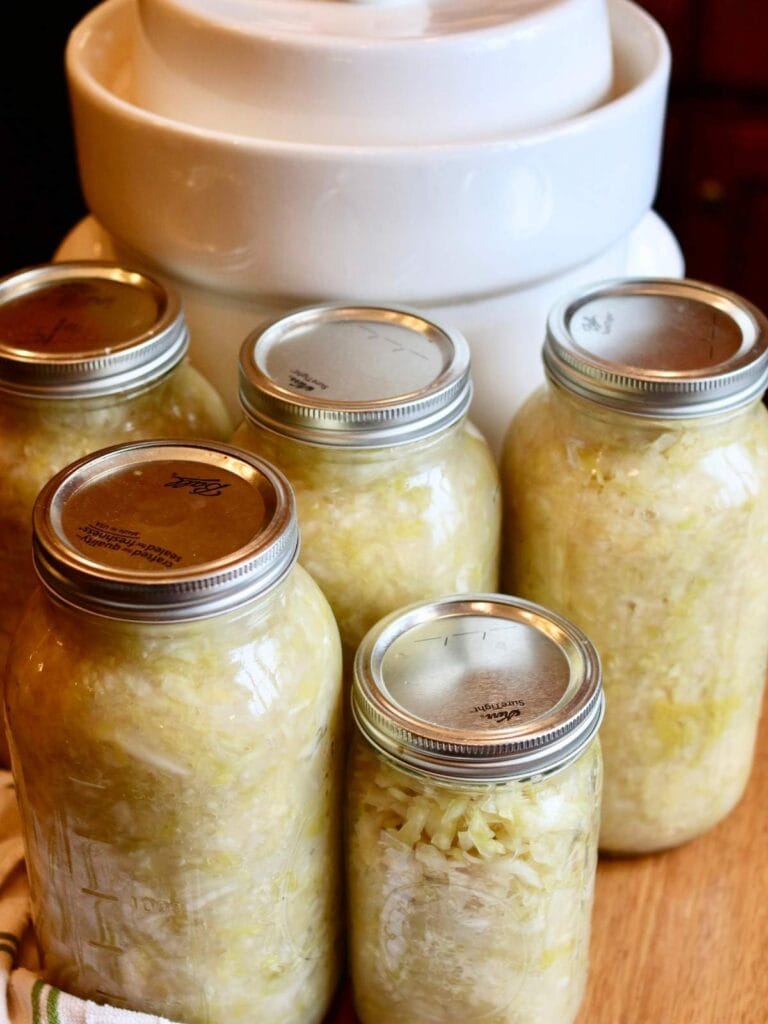
Step 10: Enjoy your homemade sauerkraut as a side dish or condiment with your favorite meals!
If you try this recipe, let me know in the comments! Tag me on Instagram @violet_rightathome
More Fermenting Recipes
How to Make Water Kefir from Start to Finish
Homemade Yogurt without a Yogurt Maker
Fermented Cranberries in Honey

Sauerkraut in a Crock
Ingredients
- Cabbage
- Salt
Instructions
- Remove the outer leaves from the cabbages, core them, then slice them thinly.
- Set aside 4-5 clean-looking whole outer leaves for later.
- Weigh the shredded cabbage and add 2% of the cabbage weight in salt.
- Toss to distribute it throughout the bowl(s).
- Let the salted cabbage rest for about half an hour so the salt can begin drawing out the moisture.
- Using a cabbage tamper, pound the cabbage until it's released about all of its juice.
- Pack the cabbage into the crock as tightly as possible.
- Cover the shredded cabbage with the whole cabbage leaves to minimize the amount of shredded cabbage floating on top of the brine.
- Place the crock weights on top and press down firmly so they're completely covered with juice.
- Put on the lid and fill the moat with water.
- Place the crock in a location between 60 and 75 degrees for about 2-3 weeks.
- Once the cabbage is done fermenting, open the crock and scoop the sauerkraut into large mason jars.
Notes
- Sea salt or Himalayan salt is best for sauerkraut, but you can use any type of salt without additives.
- Make sure to save any extra sauerkraut juice as a starter for other ferments or to use in recipes!
- If the temperature is warmer than 75 degrees, wrap the crock in a damp towel to keep it cool.
Nutrition
If you love this recipe, please make sure to come back and leave a comment and a 5 star rating. I’d love to hear how it turned out for you!
Also, I’d love to have you part of the Right At Home community! Make sure to join my newsletter for all the latest recipes, DIYs, and motherhood encouragement.







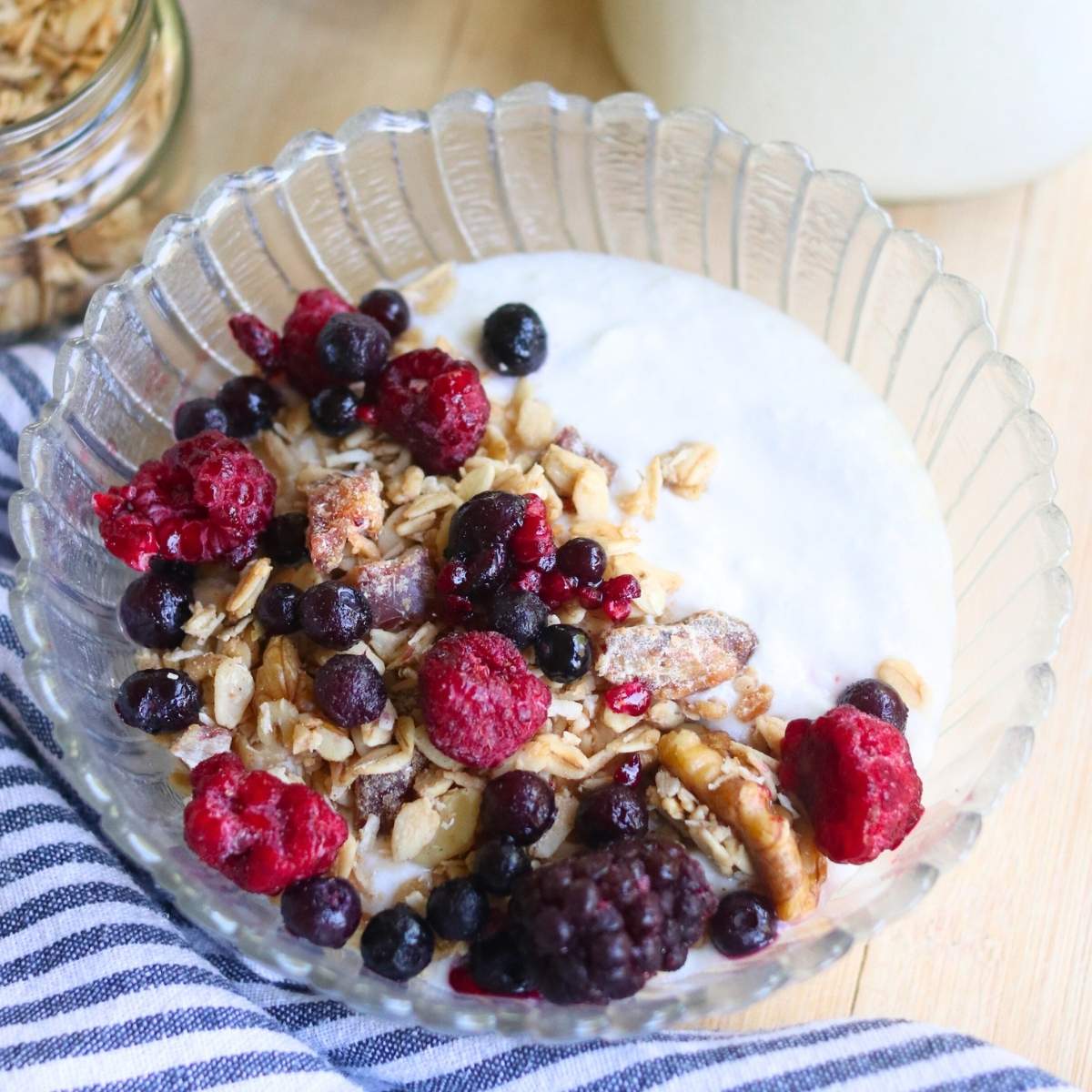
This is my all-time favorite method for making delicious sauerkraut! Let me know if you have any questions on the process. I’d love to help!